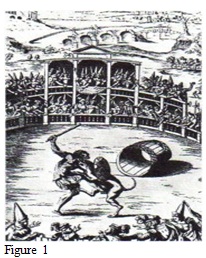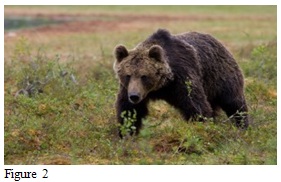Curious Animal Law Stories: Criminal Procedure Vocabulary Practice
Veronika de Azevedo Camacho, Czech Republic
Veronika de Azevedo Camacho is a teacher of Legal, Business and Academic Spanish at Masaryk University Language Centre, Brno, Czech Republic. Current professional interests are applied linguistics, methodology, pragmalinguistics and translatology.
E-mail: camacho@econ.muni.cz
Menu
Introduction
Unit outline – methodology
Exercises
Texts
Sources
The aim of this activity is to make the process of acquiring the legal vocabulary more enjoyable using humor and hyperbole.
Level: B2
Goal: vocabulary practice and revision, revision of individual phases and parts of criminal procedure
Skills: speaking (brainstorming, sharing knowledge), writing (students select and write either the final advocate´s summing up defense speech or the judge´s summing up speech), reading (students read two short texts on the Criminal Procedure topic)
Time: 45 minutes
Preparation: photos with two short humorous texts about animals brought into court provided by the teacher, two Criminal Procedure vocabulary exercises – matching the expression with its synonym/definition, matching the verbs and the nouns, Criminal Procedure revision exercise (subjects, parts, phrases - matching)
Procedure:
- Class revision of the Criminal Procedure vocabulary, verb-noun matching exercise (see the table below, Figure 1).
- Class revision of the basic Criminal Procedure vocabulary, synonyms/definitions matching exercise (see the table below, Figure 2).
- Class revision of the principles and individual phases of the Criminal Procedure (see the table below, Figure 3).
- Summing up the principles and phases of the Criminal Procedure – brainstorming, sharing knowledge.
- Introduction to the reading activity- brainstorming to generate ideas concerning the photos and titles of two short texts (“Trial of ordeal”, “Lawsuit Inter pares”) about the dog and the medieval Trial of ordeal and the bear and the Lawsuit Inter pares (see the table below, Figure 4 and 5).
- Students work in pairs, they select one of the texts and their task is to write either the final advocate´s summing up defense speech for the bear or the judge´s summing up speech in which the reasoning of the “Trial of ordeal” is given in favour of the dog.
- They post the final result in shared on-line environment (e.g. Google docs or wikis), for their classmates to compare.
The results:
Based on the texts provided and the acquired vocabulary, students write a short legal text using not only their knowledge, but also imagination and humor. The theoretical knowledge of the parts and individual phases of the Criminal Procedure are also revised.
I. Criminal Procedure vocabulary – Match the verbs and nouns.
los hechos las normas procesales a alguien por asesinato
su culpabilidad el juicio a muerte
|
Ej. 1. NEGAR los hechos.
2. CONFESAR .
3. PROCESAR .
4. CONDENAR .
5. ANULAR .
6. VIOLAR .
II.
a. Criminal Procedure vocabulary – Match the expressions (column A) with its synonyms or short descriptions (column B).
| A | B | C (a-j) |
| juicio | persona que toma la iniciativa en un proceso | |
| sentencia | conjunto de actuaciones, autos y demás escritos en cualquier causa civil y criminal | |
| enjuiciamiento | persona que tiene autoridad y potestad para juzgar y sentenciar | |
| demandante | dictamen o resolución de un juez | |
| homicidio | persona que da motivos para creer que ha cometido una acción delictiva | |
| asesino | persona/s que ejerce/n cierta potestad de mandar y hacerse obedecer | |
| proceso judicial | tribunal no profesional ni permanente que tras el juicio debe declarar si considera culpable o inocente al acusado | |
| sospechoso | juicio de Dios | |
| juez | persona que ha cometido un delito | |
| prueba | la persona que mata a alguien con alevosía o premeditación | |
| ordalía | razón o argumento con que se demuestra la verdad o falsedad de una cosa | |
| autoridades judiciales | razonamiento/exposición final del abogado en el juicio para defender a su cliente | |
| jurado | la acción y efecto de enjuiciar | |
| culpable | muerte causada a una persona por otra | |
| alegato | discusión judicial entre partes | |
II.
b. Criminal Procedure vocabulary – Match the expressions (column A, previous exercise) with the different principles and individual phases of the criminal procedure (column C).
| C |
a) partes del juicio
c) denominación del crímen
e) categoría de la persona inculpada
g) tribunal de justicia
i) ejecución penal
|
b)principios y garantías del proceso
d) escritos procesales
f) letrados en derecho (ejecución de pena)
h) los medios de aplicación de la justicia
j) tipo de juicio
|

Ordalía (Trial by ordeal)
Una sentencia popular, recogida por el escritor Guilbert Pixérécourt, cuenta que en el año 1400, en Montargis, se le concedió a un perro Mastín la categoría de demandante en un proceso por homicidio. El perro, Fiel, pertenecía a Aubry de Mondidier, quien era miembro de la Guardia del rey Carlos V de Francia. De Mondidier murió a manos de un rival, quien enterró el cadáver en el campo a efecto de que el mismo no fuera encontrado. Se dice que Fiel, que presenció la escena, condujo a los alguaciles hasta el lugar en el que estaba sepultado el cuerpo de su amo, y que cada vez que veía al asesino gruñía amenazadoramente. Aquello resultó muy sospechoso, por lo que el rey permitió que el perro se presentara como demandante en un proceso judicial. El criminal, lógicamente, negó los hechos. Los jueces se preguntaban a quién creer: ¿al hombre o al perro? Por eso, y con la finalidad de obtener pruebas que aclararan los hechos del juicio, se decidió organizar una ordalía, es decir, un “juicio de Dios”, que consistió en un duelo a muerte entre el hombre y el animal, partiéndose de la base de que, supuestamente, el Señor favorecería a quien tuviera razón. Armado con un gran escudo y una larga espada, el asesino tenía una ventaja sobre el perro. Pero la tenacidad de Fiel se impuso sobre la superioridad armamentística de su adversario, quien acabó tumbado en la arena con la mandíbula del can en su garganta y confesando su culpabilidad.

Justicia Inter pares (Inter pares Lawsuit)
En Holanda, en el año de 1685, un oso atacó y mató a un hombre. Como consecuencia de este acontecimiento, la comunidad, preocupada por su seguridad, solicitó a las autoridades judiciales que se procesara al oso por asesinato. Una vez que fue conformado el jurado con miembros de la comunidad y seguido el juicio por todas sus fases, el oso fue encontrado culpable y, por lo tanto, condenado a muerte. Sin embargo, el abogado del oso trató de anular el juicio diciendo que se habían violado las normas procesales de enjuiciamiento. El alegato se hizo consistir en que las normas de enjuiciamiento criminal establecían que quien fuera llevado a juicio por asesinato debía ser juzgado por sus pares, lo que en este caso no se había cumplido, ya que el jurado que había condenado a muerte al oso había sido conformado por seres humanos y no por osos.
Photos and texts
http://vlex.es/tags/casos-judiciales-curiosos
www.quo.es/ser-humano/juicios-de-animales/un-perro-demanda-a-un-humano
http://listas.20minutos.es/lista/animales-enjuiciados-y-encarcelados-ii-300726/

Please check the Creative Methodology for the Classroom course at Pilgrims website.


|